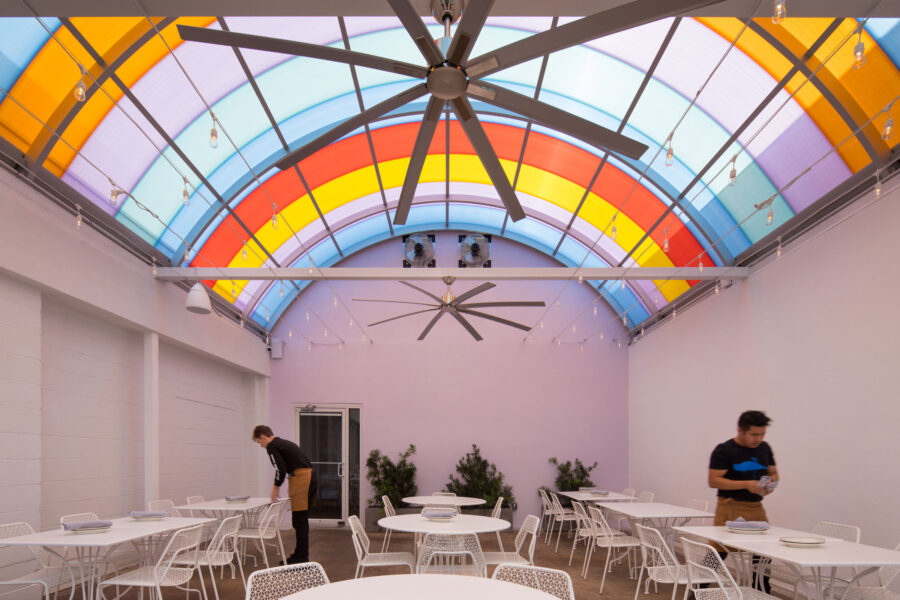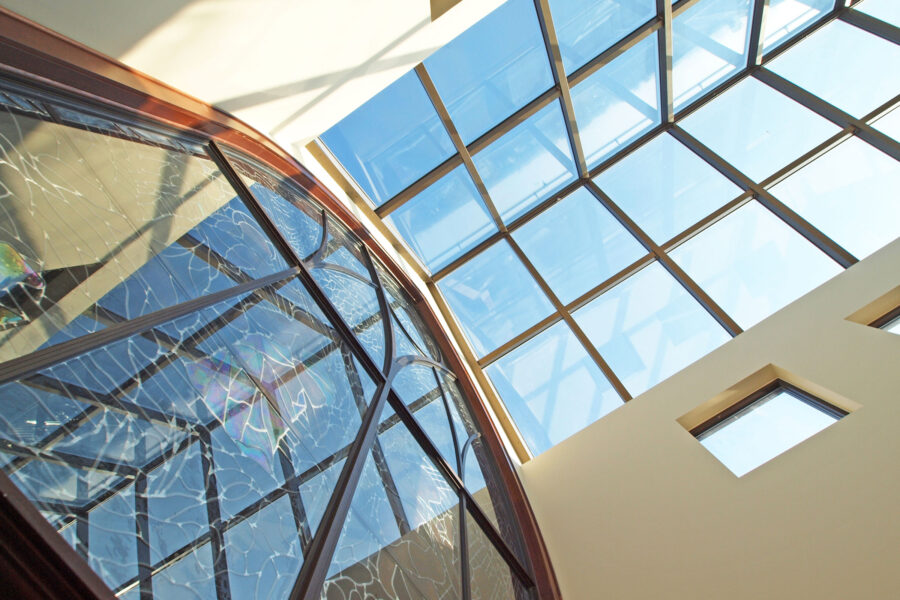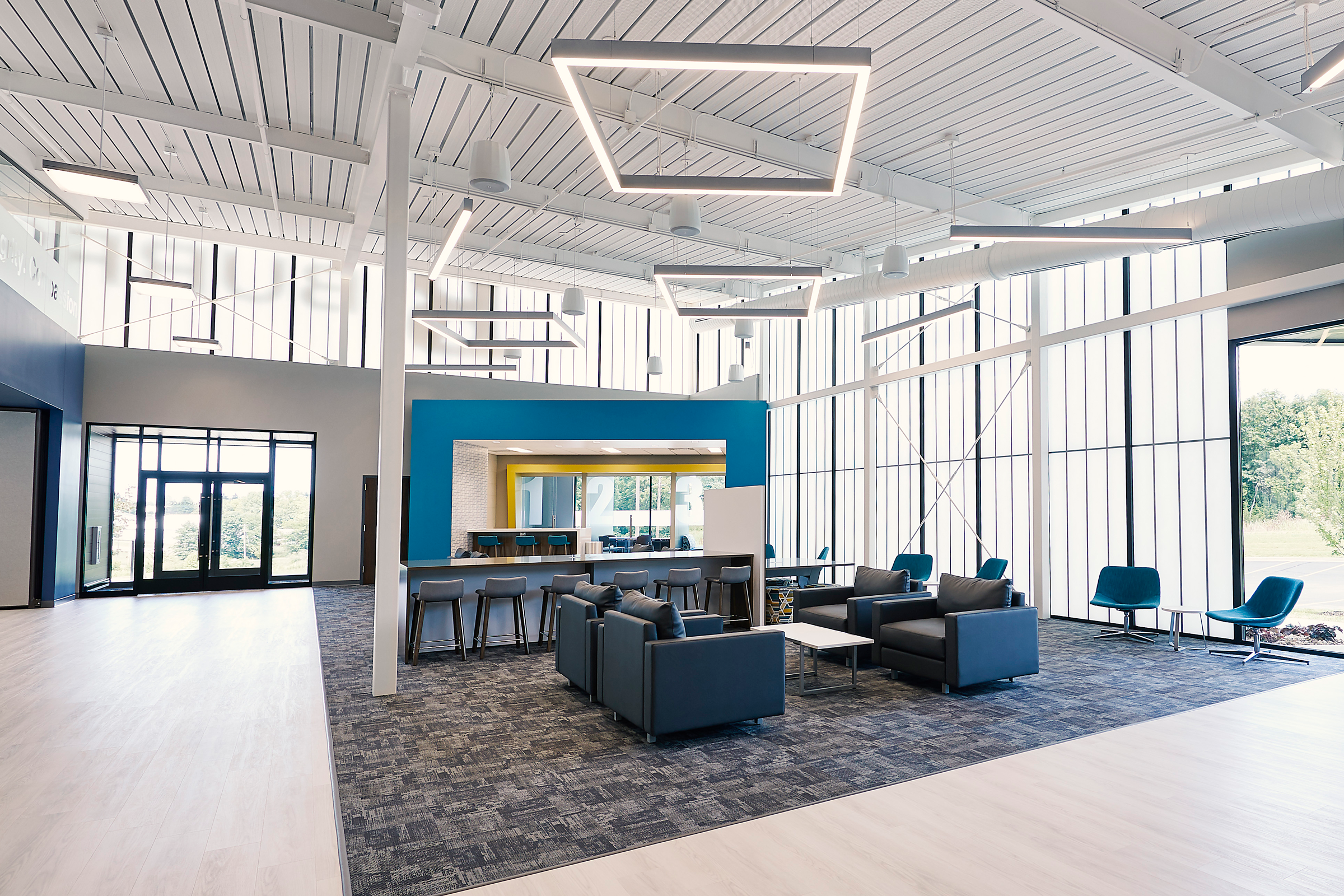Story at a glance:
- Daylighting has come a long way from problematic punched holes and windows to solutions that emphasize occupant wellness and energy efficiency.
- Kingspan Light + Air is filling a void in the industry with the new KlearSky metal framed glass skylight daylighting system.
By now you’ve heard the statistic: The average American spends 93% of life indoors. An estimated 87% of that is inside buildings (the rest in vehicles). That’s not a lot of time soaking up the sun. And while more offices, schools, and even hospitals are emphasizing outdoor spaces as part of their design, the quality of light you get indoors matters.
“More often than not daylight is seen as this nice amenity; it’s not a must-have feature of a building. Today we’re on the cusp of really understanding that daylight is one of the most important parts of a building to make people healthier and happier,” says Neall Digert, vice president of innovation and market development at Kingspan Light + Air.
Daylighting helps create a stimulating and productive environment for building occupants while reducing as much as one-third of total building energy costs, according to the Whole Building Design Guide.
Just as ventilation and HVAC have evolved to today’s standards in which you cannot design a building without proper ventilation, the same will soon be true of daylighting, Digert says. “In the very short term we’re going to see an evolution of codes where you really can’t design a building without daylight.”
We recently sat down with Digert to learn more about the evolution of daylighting and the modern daylighting solutions architects need. Digert has studied structural engineering, lighting, and energy and focused his Ph.D. on the biological and psychological impacts associated with daylight. He’s now been with the Kingspan and Solatube families—leaders in innovative lighting and more—for more than 20 years.
How has the concept of daylighting evolved?

Kingspan Light + Air’s Briteway Canopy System offers shelter and protection for building occupants plus the benefits of diffused natural light. Photo courtesy of Kingspan Light + Air
Daylight has been experiencing a renaissance in the last decade or more. We started to really understand the benefits back in the ’80s and ’90s. While we knew there were benefits at that time, we didn’t fully understand why daylight was so important—why it was a fundamental part of how people operate and live.
Today we’ve moved beyond anecdotal benefits to truly understand the fundamental biology of daylight—why it affects us biologically and psychologically, and why it’s such a key part of building design today. We’re seeing an evolution of codes and design standards all start to really address the biological need for daylight in interior spaces.
How have daylighting solutions themselves changed?
When I started doing this we had an array of products and you picked a typology—window, curtain wall, skylight. You had to pick and choose from various offerings to find a company that offered the solution you were looking for. You had to create your own portfolio of solutions, and every company tended to have different data; some had CAD details, some had thermal performance data, but it wasn’t always consistent. The design process was really complicated.
How has Kingspan Light + Air done that differently?

Photo courtesy of Kingspan Light + Air
We have a one-stop shop for all things daylighting. For the first time in the industry, architects, designers, building owners, and even contractors have a single point of contact with technologies in all forms of building fenestration.
You not only have this wide portfolio of products, but you also have consistent data and information across products. As a designer I can have confidence that when I’m working on my project late at night and trying to come up with a solution for a meeting the next morning, I can find what I need to design my project and have a coherent solution in a short time, which is very helpful.
How do you apply daylighting thoughtfully in a project?
Every project is different. The Kingspan Light + Air Architectural Solutions Team is there to ensure the design team is making informed decisions all along the way—that they understand how the nuances of decisions will impact the long-term performance of a project or even the perception of items within the building. You have this high-quality, informed base. That is so critical today, and it’s been missing in the design world.
What does the Architectural Solutions Team do, exactly?
This group of consultants is available to assist as part of the design team. These are not salespeople; they are not focused on selling a skylight or a window. They are experts in their fields in building envelopes or interior design or curtain wall design or architecture in general. They’re certainly experts in daylight code requirements, and they know how to determine the daylighting solutions’ efficiency and associated occupant satisfaction.
How is Kingspan Light + Air pushing the industry forward?

KlearSky metal framed glass skylights include standard configurations like pyramids, polygons, segmented barrel vaults, single slopes, and ridges as well as fully customizable shapes for complete freedom of design. UV-stable glass glazing options are also available to meet stringent energy code performance requirements. Photo courtesy of Kingspan Light + Air
We are always innovating new technologies and processes to make buildings or Kingspan solutions even more efficient—from an energy standpoint, a carbon footprint standpoint, and a longevity, maintenance, and even installation standpoint.
We recently launched KlearSky. This is a significant, revolutionary evolution of architectural skylights. Some interesting new technologies are being applied to make it more accessible to architects and more easily applied by the contractor.
From a product and design standpoint we have a lot of innovations that allow us to improve age-old issues with fenestration. We have new technologies that provide significantly improved thermal performance, the ability to implement different framing systems or solutions, better thermal breaks, and things that haven’t existed in the industry before or are better than what traditionally existed—like improved strength.
We’re also innovating new framing systems that allow for significant improvement in the ease of assembly of components on the job site. In some of the framing solutions we’ve developed, we’re reducing the number of fasteners that go into the purlin joints by 75%. Think about the time savings the contractor sees. Not only are we saving time by reducing the complexity of the joints, but we’re eliminating the potential for failure over time.
What do people get wrong about daylighting solutions?
When people think of skylights and daylight, they think of heat, leaks, and all these issues you could have dealing with the building envelope. With modern technologies those are all engineered out. KlearSky is a great example. We’ve taken hundreds of years of knowledge of skylights and applied the very latest in framing technologies, gasketing technologies, and glazing technologies. That allows us to have these enhanced systems that are far better at efficient light, air, and water mitigation and control than have existed in the past.
What are other benefits of KlearSky?
Whenever anybody talks about daylighting or toplighting, we go back to these beautifully glazed atriums with systems overhead. These skylights start to provide the meaningful aesthetic of the space. They give form to the building. KlearSky is this incredibly robust product that not only has all this incredible design and technology that goes into the installation and construction, but it really gives the architect this incredible flexibility to develop meaningful architecture, too.
Where is KlearSky best used?

A metal-framed glass skylight is a focal point at the Hartford Armory. Photo courtesy of Kingspan Light + Air
Anywhere that’s had architectural skylights in the past, KlearSky is the new enhanced solution available. It could be a glazed pyramid of a main circulation corridor in a corporate building. It could be ribbons of glass that undulate over a beautiful airport concourse. It could be a central atrium of a large hotel or convention center where we’re trying to not only have views to the outside but have meaningful daylight as a light source.
Anywhere you want to create interesting moments within the architecture as visual waypoints, or experiential points in the architecture, that’s where we see KlearSky becoming an incredibly powerful tool.
How else does Kingspan improve the design process?
We work with the architect or design team to go above and beyond to do incredible solutions that are stylistically or fully integrated into the overall language of the building.
We’ve innovated a whole suite of design resources, including BIM and CAD details, so when an architect is working in Revit they have the ability to develop their conceptual designs more effectively with the product components and make sure it will work in their building.
Once they have their conceptual design, that’s when our internal experts can work out the fine details of how the framing interacts with the roof deck, the structural system, and so forth, so in the end the architect has this well-crafted, issue-free design solution. When it goes to the contractor, the contractor can easily construct the KlearSky solution on the job site.
How have solutions changed to be more aesthetically interesting?

KLA’s UniQuad Poly Wall System brings light into the Maryland Heights Community Center. Photo courtesy of Kingspan Light + Air
We can develop these incredibly complex forms that 30 years ago would have been agonizing to design and fabricate. Now the whole process flows from a conceptual design on a computer monitor to the construction and fabrication details to the finished product. That flow is pretty seamless with a company like Kingspan where we’re designing everything in the three-dimensional digital world, and that digital world is informing the manufacturing process.
I was reviewing a project with a colleague this morning where the architect had this airport terminal concept with long corridors and jetways on either side. In it the roof has a really intricate, undulating pattern of ribbons, and the ribbons are skylights. It’s no longer this boring, linear strip; it enlivens the space.
More often than not, lighting is a critical part of the visual language.
How does daylighting affect occupant wellness?
We’ve always known daylight is different from electric light. Electric light is static, unchanging, and it doesn’t provide the meaningful variation our brains and our physiology crave.
We’ve all experienced how daylight provides two very important visual cues. First, the spectral content of daylight changes based on time of day. Whether it’s sunrise, sunset, or solar noon, the spectral content of daylight will always be the perfect light source. It’s still the light source by which all other light sources are compared because all colors of light are always present.
That subtle change of spectral content becomes really important for us biologically. Our bodies are designed to receive that input, and that input drives how and when we produce specific hormones and neurotransmitters, allowing us to function over the course of the day. The rise and fall of daylight drives our physiology and psychology, and we want the rise and fall of light levels.
Daylight is the number one amenity we can apply to a building that drives human satisfaction and comfort.
We want that variability because it keeps our brains awake, connected, and attuned to what we’re doing. If we put people in an interior conference room without daylight, we can lose perception of the passage of time. People start to get irritable and feel drained. There are all sorts of issues that go along with that, whereas when we add daylight to that space, the spectral content gives us important time-based information, and the variation of the daylight keeps our brains awake. It plays an important role in how we function mentally over the day.
In my mind daylight should be the dominant light source in any space, and then electric lighting becomes the supplemental resource to balance the space if we need it.
In the case of KlearSky, the directionality of light in large spaces starts to reinforce the fact that we’re in natural environments—that we’re in spaces that nurture us and make us feel happy.
How does daylighting align with sustainability?
Sustainability is more than just energy efficiency. We’ve all been in highly efficient buildings from the ’80s and ’90s, and they were just awful. Even though they had probably the latest mechanical systems and efficient glazing systems and envelopes, they weren’t comfortable. It didn’t feel right.
When we start to apply daylight in a meaningful way, we create spaces that are not only energy-efficient because we’re displacing the largest energy consumers in the building, namely electric lighting, we’re displacing or minimizing the cooling load in the space as well. And we’re creating a space that nurtures the occupants.
Ultimately a building is there to house us, to keep us happy, and to make us comfortable. Daylight is the number one amenity we can apply to a building that drives human satisfaction and comfort.

